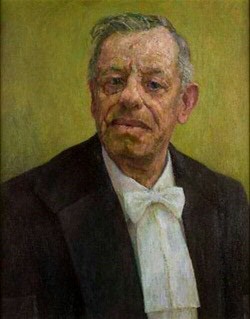Who was professor Keuning?

Until the autumn of 2022, events for alumni were organized by the Professor Keuning Association. But who is professor Keuning?
The history of what is now the Faculty of Spatial Sciences of the University of Groningen begins in 1948. Hendrik Jacob Keuning was appointed professor of economic and human geography at the new Faculty of Economics on 17 August. At the request of the university board, Keuning started an independent study in human geography in 1950, two years after his arrival in Groningen. The university would thus start the third geography program in the Netherlands, next to Utrecht and Amsterdam. Nijmegen and the VU University in Amsterdam would follow years later.
Professor Keuning saw opportunities to increase the influx of students by offering students the possibility to become both history teachers and geography teachers. Keunings teaching mandate expanded by also appointing him to the Faculties of Arts and Philosophy and the Faculty of Mathematics and Physics. The latter because "Physics Geography and Land Description" since then also become part of the teaching assignment. Physical geography is now a required part of the Human Geography program. The new degree program would not be housed at the Faculty of Economics, but at the "United Faculties of Mathematics and Physics and Letters and Philosophy". It was also explicitly established that a doctorate in human geography gave access to the doctoral degree in the Faculty of Arts and Philosophy, and not in that of Mathematics and Physics or Economics.
In the first year of the program, there were only 6 students enrolled, but five years later there were already 58. Nevertheless, as far as the main subject of human geography is concerned, the program still functioned as a one-man company. Willem Frederik Hermans had been teaching physical geography since 1952, first as a staff member and from 1958 as a lecturer, but Professor Keuning was not allowed to hire a first full-time staff member for social geography until 1957.
The memory of Keuning as one of the great scientists of his time is no less, and is determined not only by his scientific work, but also by the great appreciation for his personality. He is modesty itself in his personal interaction at the sub-faculty. His reservations about some areas and approaches in the field never lead to frustrating colleagues or blocking new developments. For example, he was skeptical of both (urban and regional) planning, which he considered too little scientific and too much application-oriented as quantitative research methods and techniques emerged during the late 1960s. But that did prevent him from creating new chairs for professors who were specifically focused on planning and research methods. Similar, although he did not see population geography as an independent specialism, he also attracted a staff member specialized in demography (Hans Zwart). With his generous and innovative spirit, he thus layed the foundations for the growth of the later Faculty of Spatial Sciences.
One of the most important elements of Professor Keuning's legacy is therefore that he has always stood for a broad understanding of the science of geography. There are many rooms in the geographic house of Keuning. Rooms each with their own design, but together a home for anyone interested in spatial developments. The ultimate name of the Faculty of Spatial Sciences would therefore have been perfect for Keuning.
---
This text is derived from the book 'Keunings Heritage - Images from the history of the Faculty of Spatial Sciences of the University of Groningen' written by emeritus professor Piet Pellenbarg.
